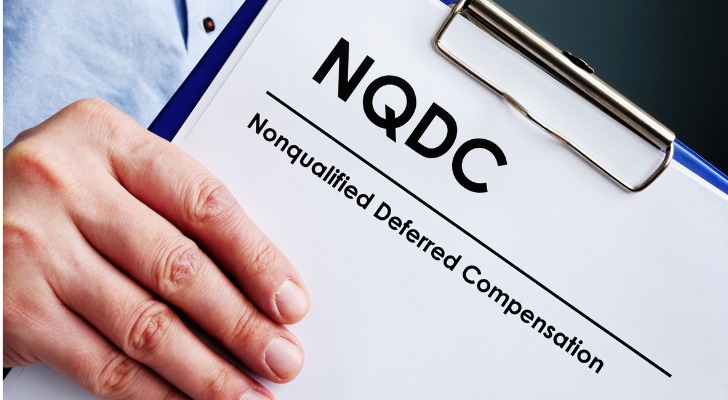If you qualify to participate in a non-qualified deferred compensation (NQDC) plan, you may want to pay attention closely. These accounts can offer high-earners who have maxed out their traditional retirement savings options an appealing opportunity to set aside a substantial portion of their income and invest it on a tax-deferred basis. In a new report, Fidelity crunched the numbers to illustrate how an NQDC plan can generate outsized returns compared to a taxable investment account.
A financial advisor can help guide you in making the most of your retirement savings accounts. Speak with an advisor today.
What Is an NQDC Plan?
A non-qualified deferred compensation plan, or NQDC, provides an avenue to defer a substantial portion of one’s compensation on a pre-tax basis. This allows participants to invest and grow their money without the immediate tax consequences of regular taxable accounts. This works in a largely similar way to traditional 401(k)s and IRAs.
As many as 80% of large companies belonging to the S&P 500 offer these plans, according to a 2020 report from Plansponsor. However, employers generally make the plans available only to a few company officers and high-earning employees. As a result, only about 518,000 high-earning employees actually participate in NQDC plans, the Plansponsor survey found.
Anyone who can participate in an NQDC but doesn’t, could be missing out on some great benefits. One of the biggest is tax deferral. Unlike the comparatively ubiquitous 401(k)s, NQDCs have no IRS-set limit on the amount that an employee can contribute each year. But keep in mind, companies may impose restrictions based on a percentage of compensation.
By deferring taxation, NQDCs provide a way to invest money that would have otherwise been lost to income taxes on current income. This means that not only is the initial sum growing, but the amount that would have been paid as tax also compounds, providing a significant boost to overall returns.
NQDC vs. Taxable Accounts
That probably all sounds good, but until you run the numbers on a hypothetical scenario you may not fully grasp what a windfall an NQDC can be. Again, that’s why Fidelity calculated just how much a NQDC could save a higher earner compared to a taxable investment account.
Fidelity considered a hypothetical employee with a 40% marginal tax rate – 35% federal and 5% state – who defers $100,000 and invests it within an NQDC plan. Assuming the money stays invested for 20 years and earns 7% per year, it would eventually be worth $387,000.
How? In the example, the $40,000 they would have paid in taxes grows by an additional $115,000 over the 20-year period, while the $60,000 generates $172,000 in additional investment earnings.
When the employee withdraws the money from the NQDC account, they’ll owe $86,000 in deferred taxes and $69,000 on the profits from the deferred income. In total, the employee nets a whopping $232,000 after taxes via the NQDC plan.
Next, Fidelity compared those results to the more traditional strategy of investing after-tax dollars in a taxable account. Assuming the same 40% tax rate, the employee would have $60,000 to invest after taxes.
Two decades later and after earning an average annual return of 7%, they’ll have $155,000. At this point they would liquidate the account and pay $10,000 in capital gains taxes, leaving them with $145,000 – $60,000 in principal, plus $85,000 in capital gains.
In the end, deferring $100,000 in an NQDC account leaves the employee $87,000 richer than simply investing after-tax dollars in a standard brokerage account. Tax drag is the main reason for this disparity, Fidelity notes. While taxable accounts incur annual taxes on dividends and other earnings, money in an NQDC account can grow tax-deferred for years and produce greater returns.
Potential Drawbacks of NQDCs

Like all financial instruments, NQDCs are not without risks and limits. For one, unlike other retirement plans, NQDC plans are technically considered unsecured promises by your employer. That means if the company goes bankrupt, your assets in the NQDC plan could be at risk.
They are also somewhat lacking in flexibility compared to other retirement plans. For instance, you can’t borrow from your account or roll over NQDC contributions into an IRA. Moreover, you have to decide how much you’ll contribute before the start of the year in which you’ll contribute. That could put you in a liquidity bind later on if something unexpected happens.
Bottom Line
NQDCs can be potent tools for wealth accumulation, particularly for high earners. Their tax-deferral advantages, coupled with the power of compounding, have the potential to lead to sizable gains. Like all investments, they also carry some risks and limitations, and are typically only available to a handful of high-earning employees at certain companies.
Wealth Planning Tips for High Earners
- Are you a high-earner considering participating in an NQDC plan offered by your employer? A financial advisor can help you plan ahead. Finding a financial advisor doesn’t have to be hard. SmartAsset’s free tool matches you with up to three vetted financial advisors who serve your area, and you can have a free introductory call with your advisor matches to decide which one you feel is right for you. If you’re ready to find an advisor who can help you achieve your financial goals, get started now.
- Chances are that your income is too high and you can’t qualify for a Roth IRA. However, you can use what’s called a backdoor Roth IRA by contributing to a traditional IRA and then converting it into a Roth version. You’ll pay taxes on the conversion, but the money will grow tax-free from that point on.
- Get retirement planning and investing tips Tuesdays through Fridays with the SmartMoney Minute newsletter. It’s 100% free and you can unsubscribe at any time. Sign up today.
Photo credit: ©iStock.com/Kobus Louw, ©iStock.com/designer491
